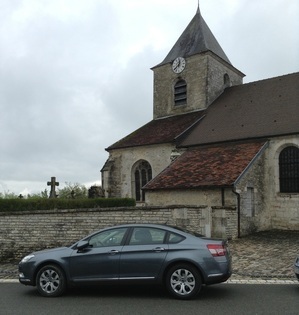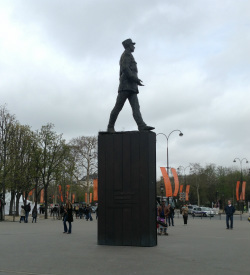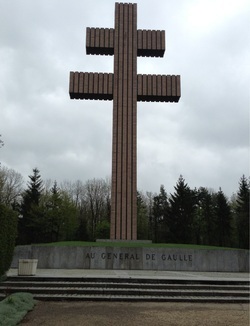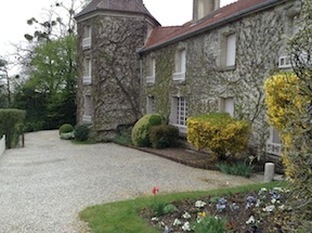Getting to Know Charles
 We're back in France, where we've had another experience that makes it fun to travel without a plan. As so often, we headed for a particular dot on our road map because we were intrigued by the name: Colombey-les-Deux-Eglises (Colombey-the-Two-Churches.)
We're back in France, where we've had another experience that makes it fun to travel without a plan. As so often, we headed for a particular dot on our road map because we were intrigued by the name: Colombey-les-Deux-Eglises (Colombey-the-Two-Churches.) The town, when we reached it, looked hardly big enough to support one church, let alone two. But it had a little hotel with flowers in the window boxes. When we'd carried in our bags we got back in the car and went to find the two churches. One Catholic, one Evangelical? we'd wondered.
 Certainly not! "Certainement pas!"
Certainly not! "Certainement pas!" The man sweeping the street in front of the church where we'd parked sounded horrified at the very thought of a diversity of churches. It seemed that centuries ago there'd been an abbey here with its own church for the monks -- both church and monks long gone.
That left us with just the one church to visit. We almost went back to the hotel without bothering, it looked so like a score of other village churches we'd passed that day, some of which we'd stopped to look at, each surrounded with its cemetery behind an encircling wall.

As we looked through the gate, though, we caught sight of fresh flowers, unusual in these forgotten-looking village cemeteries. Stepping inside, we saw a fresh bouquet and a plaque "to the memory of General De Gaulle" at the foot of a cross.

Other plaques in his honor were stacked five and six deep against the side of the church -- two sides of the church, in fact, were lined with these tributes from various organizations around the country. We learned later that there's never been a week since his death in 1970 that fresh flowers haven't been left here "for the General."

It wasn't our first encounter with him on the trip. We'd landed at Charles De Gaulle airport outside Paris, and passed him on his lofty perch on the Champs Elysses.
 Searching now among the often-ornate headstones of the little country cemetery, we came upon an eloquently simple one. The stone on the right marks the grave of De Gaulle and his wife, Yvonne, the one on the right, their daughter Anne with the dates 1928-1948. I remembered reading occasionally about the De Gaulles' son Phillipe and their daughter Elisabeth, but never about Anne.
Searching now among the often-ornate headstones of the little country cemetery, we came upon an eloquently simple one. The stone on the right marks the grave of De Gaulle and his wife, Yvonne, the one on the right, their daughter Anne with the dates 1928-1948. I remembered reading occasionally about the De Gaulles' son Phillipe and their daughter Elisabeth, but never about Anne. We learned her story next day at the big new De Gaulle museum on the outskirts of this tiny town. We learned, too, about the immense construction we'd seen from many miles away the previous day. A military installation? An enormous satellite tower? It was the Croix de Lorraine, a museum guide explained, the Lorraine Cross chosen be De Gaulle during the long Nazi occupation as the emblem of Free France. I remembered, then, selling stamps with this symbol around my high school to raise money for the Free French fighters.

I took an elevator to the roof of the museum, then climbed some more to the top of the hill where the cross stands. Ponderous and graceless, I thought, but still a powerful symbol of the man who flew to England while the French leadership was making deals with the victorious Nazis, broadcast an appeal to his countrymen to resist, and led that resistance for four long years.
 Museum entrance: my favorite statue of De Gaulle. Most of the museum is given to exhibits about the war and De Gaulle's political career afterward.
Museum entrance: my favorite statue of De Gaulle. Most of the museum is given to exhibits about the war and De Gaulle's political career afterward. But one room is dedicated to his family. Phillipe and Elisabeth have had distinguished careers of their own. But the youngest, Anne, was born with Down's Syndrome, a condition "little understood in 1928," when most such children were cared for in institutions. The De Gaulles kept Anne at home. Though she never learned to talk, and didn't walk until age 10, she was her father's special joy. He sang to her at bedtime each night, walked her about the estate that they bought in Colombey-les-Deux-Eglises largely because doctors thought the country air would benefit Anne's fragile health.

We liked this glimpse of another side of this combative man and went to see the estate, "La Boisserie."
The house is at the foot of this drive, large but unpretentious, with the views over the surrounding farmlands that Anne especially enjoyed.

 We were glad we'd stopped at the Town-with-Two-Churches!
We were glad we'd stopped at the Town-with-Two-Churches!
Published on June 14, 2013 09:40
No comments have been added yet.



